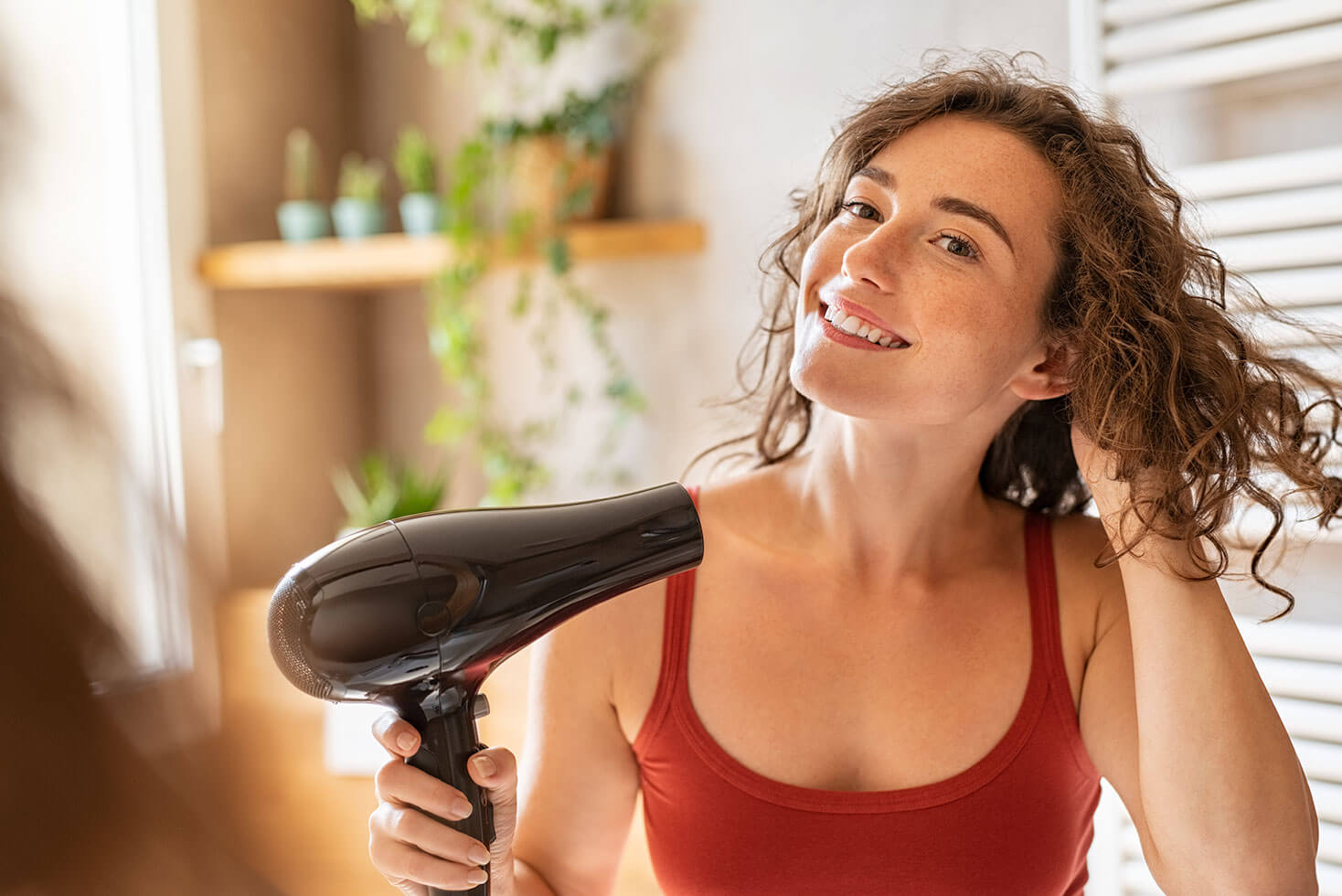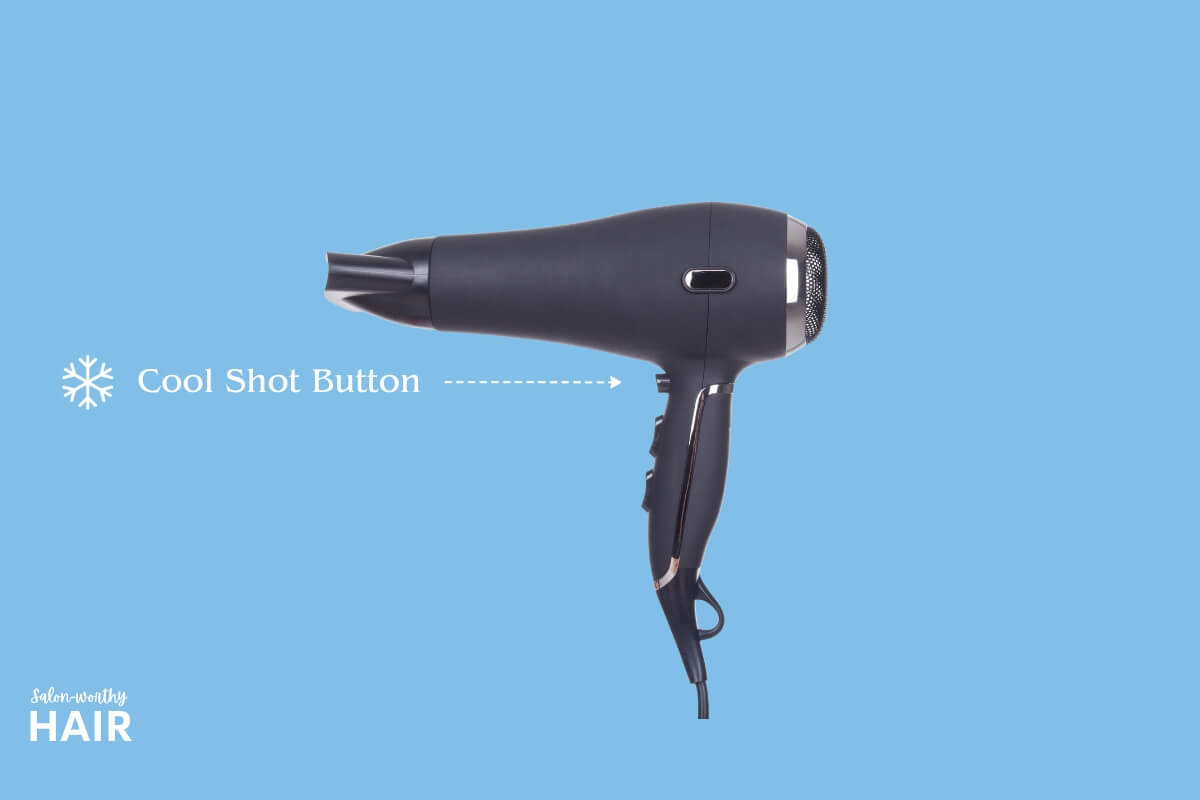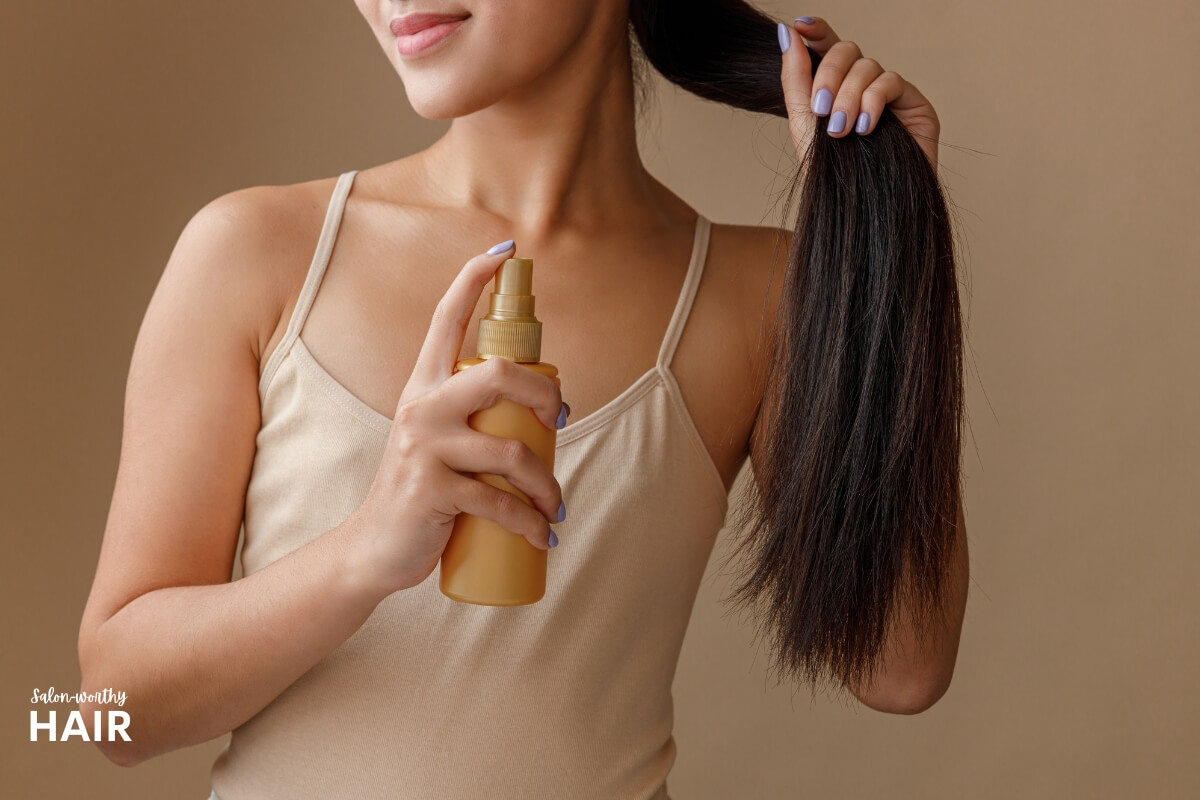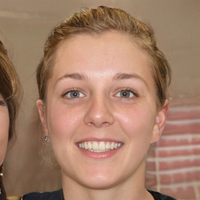10 Brilliant Tricks to Instantly Fix Frizzy Hair After Blow Drying
Updated on
This post may contain affiliate links. As an Amazon Associate, we may earn from qualifying purchases.

15 minutes to blow dry. 30 seconds to frizz!!
I’ve tried every trick in the book. Bought the most expensive hair dryer, tried a nozzle attachment, and used heat protectants and blow-dry creams, but aargh!
I still ended up with flyaways sticking out in every direction.
The relationship between blow drying and frizz is nuanced. While blow drying uses heated airflow to extract moisture for faster drying and styling, it can also increase frizz due to rapid moisture loss from the hair.
Heat from a blow dryer can lift the hair’s cuticles, leading to a rough texture and appearance that manifest as frizz and flyaways. Repeated wetting and blow-drying can further exacerbate the problem causing multiple cracks in the hair cuticles.
The problem with frizzy hair is that it is very unpredictable and resistant to styling, which defeats the purpose of blow drying.
So, how do you mitigate frizz once your hair is dried up, assuming it’s not fried from the heat?
Well, here are the quick ways to rescue your hair from a post-blow-dry frizz conundrum:
- Use the cool air blast straight away
- Pat your hair down with a microfiber towel
- Use a hydrating hair serum or oil
- Use a light hair spray or gel
- Wrap your hair with a silk or satin scarf
- Lift your roots with dry shampoo
- Try the pineapple hair trick
- Use a wide-tooth comb Instead of Brush
- Apply a small amount of cold water
- Stay away from a humid bathroom
Below, I explain how each method works to calm frizz after blow drying and how to prevent it from happening again.
1. Use the Cool Air Blast

A cool air blast fixes static and flyaways by helping to close and smooth down the hair cuticles, which have been roughened or lifted during the warm blow drying process. Smoother cuticles allow hair strands to align neatly, minimizing the repulsion between them. The cold hair lowers the temperature of the hair, reducing the static charge, which in turn minimizes flyaways for a smoother overall appearance.
The use of hair dryers, particularly at high temperatures, contributes to surface damage of hair strands, resulting in heightened flyaways and static, according to Lee, Y., et al., “Hair Shaft Damage from Heat and Drying Time of Hair Dryer,” Annals of Dermatology, 2011.
The drying process dehydrates hair, upsetting its natural charge balance and leading to static buildup. Brushing your hair while blow drying generates friction, which further strips electrons from the hair, increasing the static charge.
Most modern hair dryers come with a ‘cool shot’ button or setting. It temporarily stops the heating element and blows room-temperature or slightly cooler air when activated. This feature is intended to be used after the hair is mostly dry and styled to set the hairstyle and improve hair texture by sealing the cuticles. It’s a finishing touch that helps maintain the style and reduce frizz.
The cool air shot is most suitable for fine, straight hair. This hair type often experiences frizz in the form of static and flyaways, especially after applying hot air from blow drying.
2. Pat Your Hair Down with a Microfiber Towel
Patting hair down with a microfiber towel can reduce puffiness in thick, coarse hair due to rapid dehydration after blow drying.
Thick, coarse hair has a denser structure, making it naturally more prone to retaining moisture. When blow dried, the intense and rapid evaporation of moisture can lead to an imbalance in the hair’s natural hydration levels. This sudden loss of moisture can cause the hair strands to react and swell, leading to a puffy appearance. The puffed-up texture is also caused by individual strands no longer lie flat and smooth after drying.
Unlike traditional towels, microfiber is much gentler on the hair and does not roughen the hair cuticles. When thick, coarse hair experiences puffiness, softly patting down the hair reduces the puffy, frizzy look by encouraging the hair strands to lie flatter against each other.
For wavy hair, which tends to frizz due to the disruption of the natural wave pattern, the microfiber towel can help redefine the waves without causing additional frizz. The gentle patting motion can enhance the natural pattern of the hair while minimizing frizz.
Aquis Microfiber Towel
3. Use a Hydrating Hair Serum or Oil

A hydrating hair serum or oil reintroduces moisture into the hair to compensate for dryness after heat styling. These products also help lay the cuticles flat with smoothing ingredients like silicone or natural oils, such as argan, coconut, or jojoba.
Flattening the cuticles minimizes the rough, uplifted texture that contributes to frizz. Moreover, serums and oils often contain ingredients that add shine and manageability, making the hair less frizzy, more lustrous, and easier to style.
Blow drying can make hair frizzy due to the effect of heat and airflow on the hair’s cuticle layer. The cuticle is the outermost layer of the hair, consisting of overlapping scales. When hair is healthy and well-moisturized, these scales lie flat, giving hair a smooth and shiny appearance. However, the heat from a blow dryer can lift these scales, creating a rough texture and making the hair more susceptible to frizz.
The forceful air can disrupt the hair’s natural pattern and alignment, especially if the hair is curly or wavy. This disruption can lead to a frizzy appearance as the hair strands no longer lie smoothly against each other.
Oils and serums form a protective barrier over the hair cuticle. This barrier keeps the cuticle flat and also locks in moisture to prevent the hair from absorbing humidity from the air. Oils, such as argan or coconut oil, are particularly beneficial for coarse or dry hair as they provide intense moisture and nourishment. Serums, on the other hand, are typically lighter and can be ideal for fine hair, offering protection without weighing the hair down.
From my experience, I found that applying a small amount of anti-frizz serum to the hair before blow drying also makes a significant difference. It helps protect the hair from heat damage, maintain moisture balance, and leave it looking smoother and more polished after styling. The key is choosing a product suitable for your hair type and using it sparingly to avoid making the hair greasy or heavy.
NEXXUS Ultralight Smooth Hair Serum
4. Use a Light Hair Spray or Gel
Light hair sprays and gels provide a layer of hold and protection without weighing hair down. Unlike heavier products, they don’t make hair greasy or stiff but rather help to tame flyaways and keep hair looking smooth and polished.
After blow drying, hair can become frizzy due to the disruption of the hair cuticle and loss of moisture. A light hair spray or gel works by lightly coating the hair strands. This coating creates a barrier that smoothens the cuticle and helps to lock in moisture, reducing the puffiness and static that contribute to frizz.
Hair sprays and gels are designed to maintain hair’s shape and style. In the context of frizz, they work by ‘gluing’ the frizzy hair strands down, preventing them from standing up or curling away. They also add a slight weight to the hair, which can help keep it in place, especially in humid conditions where frizz is more likely to occur.
When applying these products, it’s crucial to focus on the ends and mid-lengths of the hair, where frizz is most visible. Avoid the roots to prevent buildup and greasiness. Additionally, alcohol-free formulas can help prevent further dryness, which is essential for those who frequently use blow dryers.
Olaplex Volumizing Blow Dry Mist
5. Wrap Your Hair With a Silk or Satin Scarf
Wrapping your hair with a silk or satin scarf is particularly effective for surface-level frizziness and lack of smoothness. This type of frizz is not necessarily due to lifted cuticles, puffiness, or static but rather from the overall texture irregularities caused by blow drying.
The hair can become unevenly dried when blow drying, especially without using a diffuser or proper technique. Some sections may dry faster than others, leading to an inconsistent texture across the hair. This irregular drying can cause some strands to appear frizzier or more unruly compared to others, leading to a lack of uniform smoothness.
Wrapping your hair in a silk or satin scarf coaxes hair strands to lay flatter and more uniformly, reducing the appearance of surface-level frizz.
This technique is particularly beneficial for those with hair that tends to react to varying drying speeds and techniques, helping to create a more cohesive, smooth appearance.
In my experience, I’ve found that using a silk or satin scarf overnight can be particularly effective. It helps settle frizz post-styling and extends the life of your blow dry, keeping it smoother for longer. A longer-lasting blow dry saves time as you can skip it on busy mornings.
Mulberry Silk Scarf
6. Lift Your Roots With Dry Shampoo
Using a dry shampoo to lift your roots primarily addresses frizz that occurs at the scalp and root area of the hair, often manifesting as a lack of volume and a matted appearance.
When blow drying, especially if the hair is dried in a downward direction from the roots, there’s a tendency for the roots to become flattened against the scalp. Flattening can give the appearance of frizz as the hair lacks lift and separation at the base, making it look unstyled or greasy, even if it’s clean. This effect is particularly true for fine, limp, or oily hair types, which are more prone to losing volume during drying.
Applying dry shampoo at the roots counteracts this by absorbing excess oil that weighs down hair, thus restoring volume and lift. It essentially ‘fluffs up’ the roots, creating a cleaner, more voluminous look and reducing the appearance of frizz on the scalp.
Flip your head upside down for an extra volume boost while applying the dry shampoo to your roots. The upside-down technique helps to lift the hair away from the scalp, maximizing volume. Then, use your fingertips to gently massage the product into the scalp, which helps with even distribution and stimulates the roots, enhancing the volumizing effect.
Eva NYC dry shampoo
7. Try the Pineapple Technique for Curls
The pineapple hair technique can tame frizz that manifests as disrupted curl patterns, especially in curly, Afro, or natural hair types.
This type of frizz arises primarily from the loss of defined curls or coils after blow drying. When curly or textured hair is exposed to the heat and force of a blow dryer, even with a diffuser, it can disrupt the natural curl formation. The curls may loosen or become uneven, leading to a frizzy appearance as the uniformity of the curl pattern is compromised.
The pineapple technique involves gathering the hair into a loose, high ponytail at the top of the head, resembling a pineapple. By loosely securing the hair on top of the head, it minimizes disturbance to the curl pattern. The pineapple method helps maintain the natural shape of the curls, reducing the tendency to frizz.
This method also minimizes the tension that can stretch out curls and contribute to frizz, especially while sleeping or moving around. It allows for the distribution of natural oils from the scalp throughout the hair, which can help naturally condition the curls and reduce frizz.
For those with very tight curls or coils, consider a modified version of the Pineapple trick where multiple loose ponytails are created around the head. Pineappling can help preserve the integrity of tighter curl patterns that might be too dense or oily for a single pineapple. It’s a simple adjustment but can make a significant difference in maintaining well-defined curls and reducing frizz after blow drying.
8. Use a Wide-Tooth Comb Instead of a Brush
Using a wide-tooth comb rather than a brush can help smooth mid-length frizz and tangling during blow drying for those with medium to thick hair textures.
Mid-length frizz happens when the high force of the blow dryer causes hair strands in the middle section of hair to tangle and separate. The stiff bristles of a brush can snag and pull at these tangles, causing more frizz.
Switching to a wide-tooth comb with gently tapered edges allows you to smooth and detangle the mid-length more gently as you blow dry. Gentle detangling helps the strands to lie flatter amongst each other rather than push apart into frizz. The width between the comb teeth also helps gather and integrate more strands. Doing this and the proper blow drying technique can lead to less pull-apart frizz and over-drying for healthier and smoother mid-length hair.
My Tip:
Wide tooth combs are often used for detangling wet hair, but utilizing them throughout the blow dry on damp hair can also make a big difference in frizz and texture. Combining the comb structure and blow dry motion takes advantage of the hair’s flexibility for maximum frizz reduction.9. Mist Your Ends with Cold Water
Misting the ends of hair with a small amount of cold water after blow drying can help smooth dry or wispy fringe flyaways.
This post-styling frizz occurs when the short layers around the face dry too fast or are missed and under-smoothed during the hot styling of a blowout.
Cold water helps reactivate the moisture and set the front face-framing fringe pieces. Gently misting the upper edge of the layered ends aids in separating, smoothing, and resetting the short strands, allowing the cooler water temperature to lightly fuse them back into place. Such a technique yields a more refined, consistently smooth fringe and front hairline.
Conventionally, more heat is applied after blow drying to smooth issues areas. But for fine front pieces that tend on the fragile side and over-dry easily, a spritz of cold water proves gentler and helps avoid worsening the appearance of flyaways or fried ends through excessive heat.
The water is a refreshing recharge for the new growth areas to combat their post-style drying.
10. Stay Away from a Humid Bathroom
Avoiding time in a steamy bathroom after blow drying helps prevent reversion frizz and poufiness for those with wavy or curly hair textures.
The humidity from a hot shower or bath can rapidly undo a fresh blow-dry’s smooth, straightened effects by re-activating texture and coils.
Hot, moist air causes strands to absorb moisture and swell. The swelling leads to undefined frizz and width as the locks spring back to their naturally wavy or coily state. The high humidity essentially overwhelms the smooth, stretched shape established by hot styling tools.
For those who need mirror time for makeup, use a mirror in another room and avoid staying in the bathroom after your shower. It will save you time needing to re-style or smooth frizzy spots before heading out the door.
How to Blow Dry Hair Without Frizz
The best way to prevent frizz from blow drying is to adopt a step-by-step routine that involves using a heat protection spray and mastering hair drying techniques such as blow drying direction, low airflow, and using the correct heat settings for your hair type.
If you have curly hair, a diffuser attachment can help. If you want precise styling, a concentrator nozzle can help you achieve that.
Ultimately, it is about good technique and, of course, using a good quality hair dryer.
About the Author
 Charlene Latreuille
Charlene LatreuilleCharlene Latreuille has been blogging for over 10 years and has a background in digital marketing.
Specializing in women's hair health, she blends scientific insight with practical advice, crafting easy-to-follow guides.




